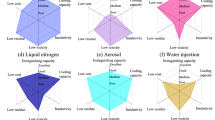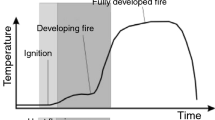Abstract
The fire-extinguishing efficiency of compressed gas protein foam with different gas–liquid ratio on diesel pool fire was studied by a laboratory-scale fire suppression experiment. The 25% drainage time, expansion ratio and fire-extinguishing efficiency of 6% protein foams (PF) with the gas–liquid ratio in the range of 5–24 were tested. The results show that as gas–liquid ratio increases, both the 25% drainage time and expansion ratio increase. In the fire-extinguishing process, the temperature drop rate increases at the beginning and then decreases with the increase of gas–liquid ratio. When the gas–liquid ratio is 20, the foam shows the optimal equilibrium between the fluidity and stability, thus exerting the maximum temperature drop rate of 6.86 K s−1 corresponding to the best fire-extinguishing efficiency. The main fire-extinguishing mechanism of PF in pool fire is ascribed to the combined actions of cooling effect and barrier effect. By adjusting the gas–liquid ratio in the range of 16–24, the PF can exert excellent fire-extinguishing efficiency in pool fire by diluting the combustible gases and isolating the transmission of heat and oxygen between combustion zone and fuel.









Similar content being viewed by others
References
Zhou R, Dou X, Lang X, He L. Foaming ability and stability of silica nanoparticle-based triple-phase foam for oil fire extinguishing: experimental. Soft Mater. 2018;16(4):327–38. https://doi.org/10.1080/1539445X.2018.1518878.
Li P, Liu J, Chen M, Wang F, Yuen R, Wang J. Experimental study of high altitude effect on heat release rates of pool fires using calorimeters. J Therm Anal Calorim. 2018;131:1597–603.
Yue H, Zhou X, Zhibo W, Xiaoyu J, Peng Y, Yang L. Ignition and burning behaviors of automobile oil in engine compartment. J Therm Anal Calorim. 2018;132:305–16.
Chaudhary A, Gupta A, Kumar S, Kumar R. Thermal environment induced by jatropha oil pool fire in a compartment. J Therm Anal Calorim. 2017;127:2397–415.
Persson H, Milovancevic M. FAIRFIRE. Firefighting foams: small scale fire test procedure. Improvements of drainage and expansion methodology. European Commission. Measurements and Testing Programme, Project MAT1-CT91-0041. 1996.
Bourgeois A, Bergendahl J, Rangwala A. Biodegradability of fluorinated fire-fighting foams in water. Chemosphere. 2015;31:104–9. https://doi.org/10.1016/j.chemosphere.2015.02.042.
Duma MJ. Full-scale testing of fire suppression agents on unshielded fires. Dissertation, University of Canterbury. 1998.
Zhang Q, Wang L, Bi Y, Xu D, Zhi H, Qiu P. Experimental investigation of foam spread and extinguishment of the large-scale methanol pool fire. J Hazard Mater. 2015;287:7–92. https://doi.org/10.1016/j.jhazmat.2015.01.017.
Chen T, Fu X, Bao Z, Xia J, Wang R. Experimental study on the extinguishing efficiency of compressed air foam sprinkler system on oil pool fire. Procedia Eng. 2018;21:94–103. https://doi.org/10.1016/j.proeng.2017.12.142.
Shin C, Jeong H. The extinguishing characteristics by fluidity variation of protein foam extinguishing agent. J Korean Soc Saf. 2014;29(2):18–23. https://doi.org/10.14346/JKOSOS.2014.29.2.018.
Alargova RG, Warhadpande DS, Paunov VN, Velve OD. Foam super stabilization by polymer microrods. Langmuir. 2004;20:10371–4. https://doi.org/10.1021/la048647a.
Goodwin J. Colloids and interfaces with surfactants and polymers: an introduction. Hoboken: Wiley; 2004.
Magrabi SA, Dlugogorski BZ, Jameson GJ. A comparative study of drainage characteristics in AFFF and FFFP compressed-air fire-fighting foams. Fire Saf J. 2002;37:21–52. https://doi.org/10.1016/S0379-7112(01)00024-8.
Zhao M, Ni X, Zhang S, Cao W, Guan Y, Liang C, Wang X, Zhang H. Improving the performance of fluoroprotein foam in extinguishing gasoline pool fires with addition of bromofluoropropene. Fire Mater. 2016;40:261–72. https://doi.org/10.1002/fam.2284.
NFPA-11. Standard for evaluating low-expansion foams. Quincy: National Fire Protection Association; 1998.
Zhu P, Wang X, Wang Z, Cong H, Ni X. Experimental study on transformer oil pool fire suppression by water mist. In: Harada K, et al., editors. Fire science and technology. Singapore: Springer; 2016. p. 895–901 (in Chinese).
Liang T, Zhong W, Yuen RKK, Lo S, Liao G. On the fire intensification of pool fire with water mist. Procedia Eng. 2013;62:994–9. https://doi.org/10.1016/j.proeng.2013.08.153.
Kim AK, Crampton GP. Evaluation of the fire suppression effectiveness of manually applied compressed-air-foam (CAF) system. Fire Technol. 2012;48:549–64. https://doi.org/10.1007/s10694-009-0119-3.
Laundess AJ, Rayson MS, Dlugogorski BZ, Kennedy EM. Small-scale test protocol for firefighting foams DEF(AUST)5706: effect of bubble size distribution and expansion ratio. Fire Technol. 2011;47:149–62. https://doi.org/10.1007/s10694-009-0136-2.
Boyd CF, Di Marzo M. The behavior of a fire-protection foam exposed to radiant heating. Int J Heat Mass Trans. 1998;41(12):1719–28. https://doi.org/10.1016/S0017-9310(97)00280-9.
Goldfarb I, Kann K, Sheiber I. Liquid flow in foams. Fluid Dyn. 1988;23:244–6. https://doi.org/10.1007/BF01051894.
Lunkenheimer K, Malysa K, Winsel K. Novel method and parameters for testing and characterization of foam stability. Langmuir. 2009;26:3883–8. https://doi.org/10.1021/la9035002.
Britan A, Ben-Dor G, Shapiro H. Drainage effects on shock wave propagating through aqueous foams. Colloid Surf A. 2007;309:137–50. https://doi.org/10.1016/j.colsurfa.2007.01.018.
Sheng Y, Jiang N, Sun X, Shouxiang L, Li C. Experimental study on effect of foam stabilizers on aqueous film-forming foam. Fire Technol. 2018;54:211–28. https://doi.org/10.1007/s10694-017-0681-z.
Acknowledgements
This work was supported by the National Natural Science Foundation of China (Nos. 51676210 and 51906261), the Hunan Provincial Natural Science Foundation of China (No. 2018JJ3668), the Science Fund for Distinguished Young Scholars of Hunan (No. 2019JJ20029) and the Graduate Research and Innovation Project of Central South University (No. 506021733).
Author information
Authors and Affiliations
Corresponding author
Additional information
Publisher's Note
Springer Nature remains neutral with regard to jurisdictional claims in published maps and institutional affiliations.
Rights and permissions
About this article
Cite this article
Ding, F., Kang, W., Yan, L. et al. Influence of gas–liquid ratio on the fire-extinguishing efficiency of compressed gas protein foam in diesel pool fire. J Therm Anal Calorim 146, 1465–1472 (2021). https://doi.org/10.1007/s10973-020-10074-6
Received:
Accepted:
Published:
Issue Date:
DOI: https://doi.org/10.1007/s10973-020-10074-6




